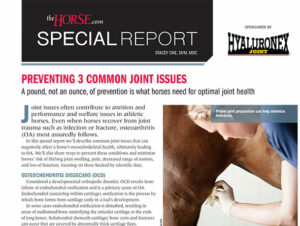
Managing Proximal Suspensory Disease in Horses
A veterinarian describes the many ways to treat this complex yet common cause of lameness and poor performance.


A veterinarian describes the many ways to treat this complex yet common cause of lameness and poor performance.

Vets can monitor trends in SAA levels post-orthopedic surgery to quickly identify and address surgical implant infections.

Keeping donor and recipient mares in moderate body condition might improve survival rates of transferred embryos.

Time is life for a foal. Here’s a look at the top causes of illness in newborn foals and how to manage a sick foal.

An equine veterinary podiatrist gives 6 steps for addressing the acutely laminitic horse.

There are 2 forms of equine gastric ulcer syndrome. A researcher describes how to prevent them.

A veterinarian describes three real-life examples of horses with physical abnormalities competing successfully.

The key concepts behind 6 orthobiologics available to equine veterinarians.

An equine internist explains how she makes testing decisions and interprets results.

A wide range of conditions can cause poor performance, but many cases circle back to lameness with a behavioral component.

Knowing what imaging and clinicopathologic tests to perform in what order is key to diagnosing challenging cases.

Learn about recent research on the causes of EIPH, how it affects horses and their performance, and furosemide use in equine athletes.

Learn how to help your horse avoid joint problems such as osteoarthritis, osteochondritis dissecans, and joint flares. Sponsored by Hyaluronex Joint.

A veterinarian describes what causes podotrochlosis and how practitioners diagnose and manage it.

Because the hooves are integral to soundness, veterinarians and farriers should work together to give lame horses the best prognosis.

A veterinarian explains how he uses serum amyloid A to diagnose many equine conditions, plus its limitations.
Stay on top of the most recent Horse Health news with